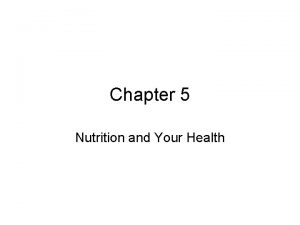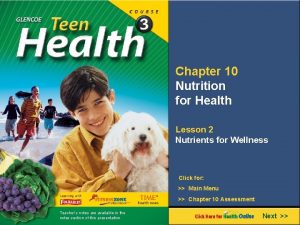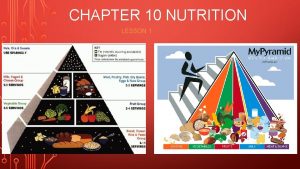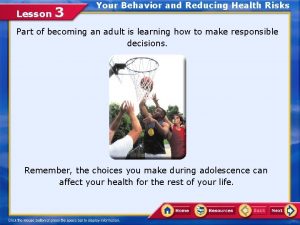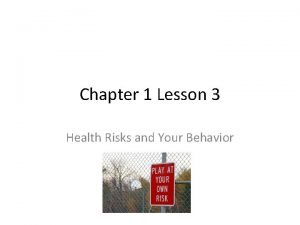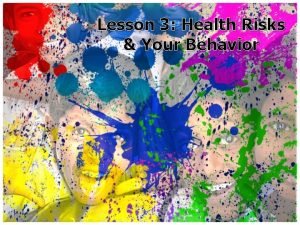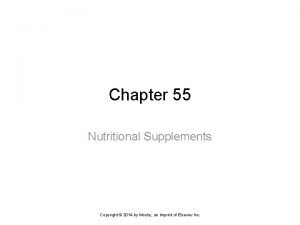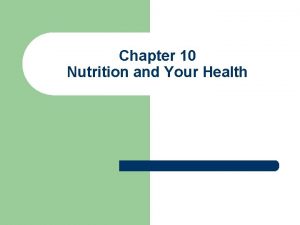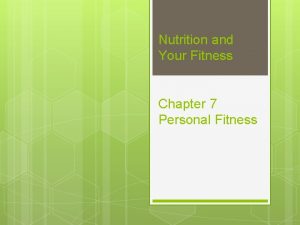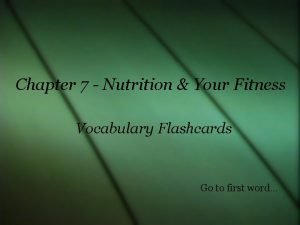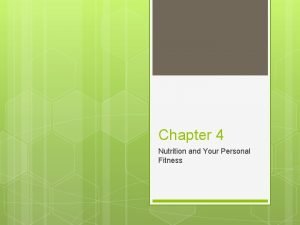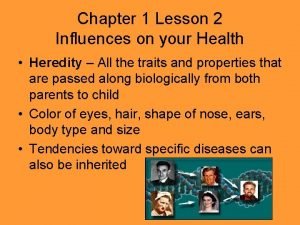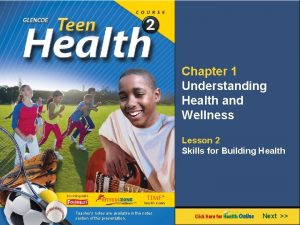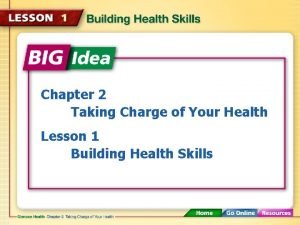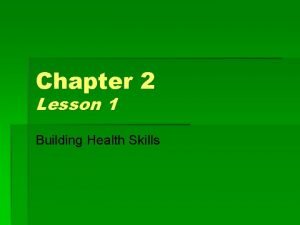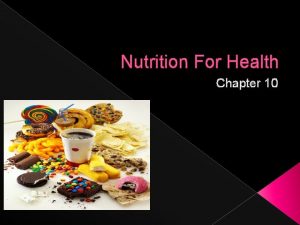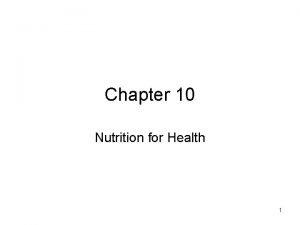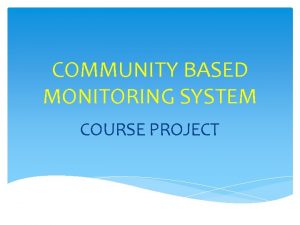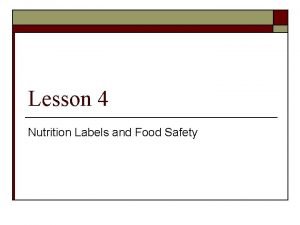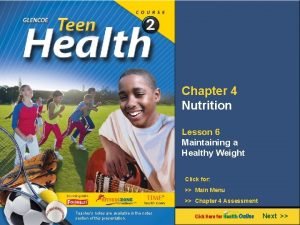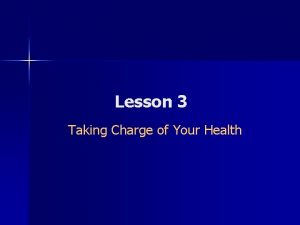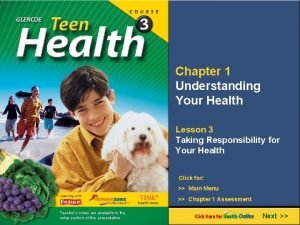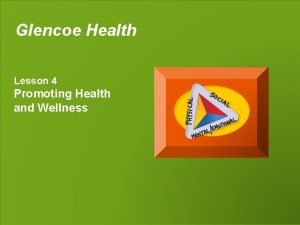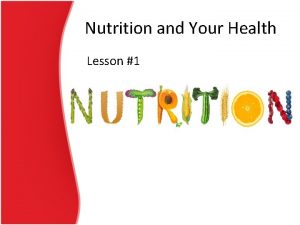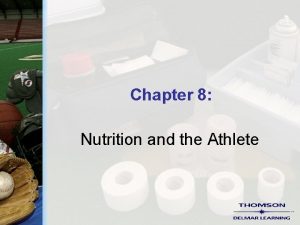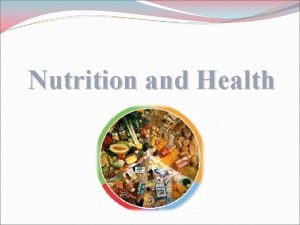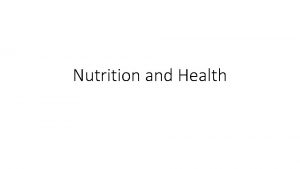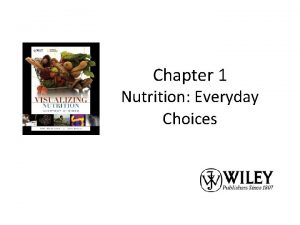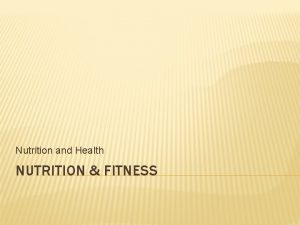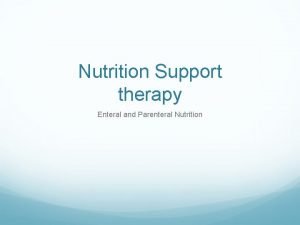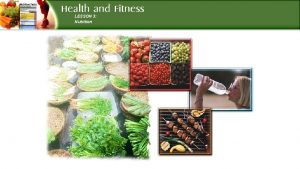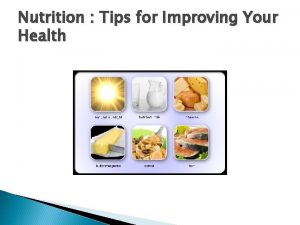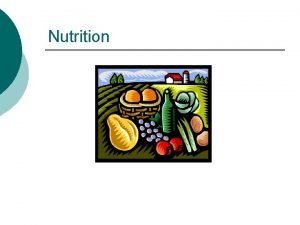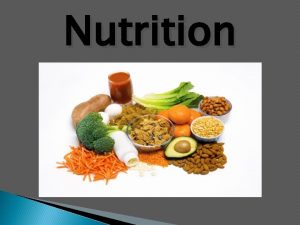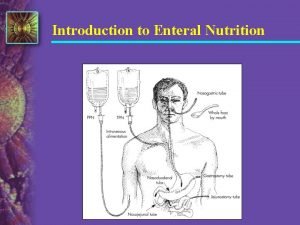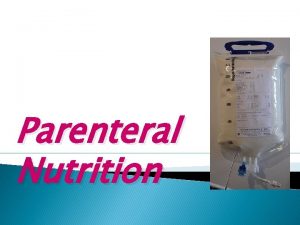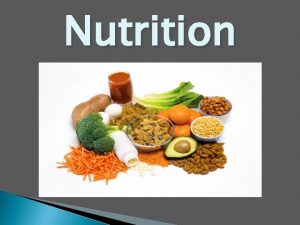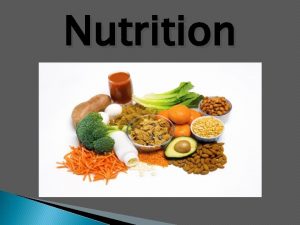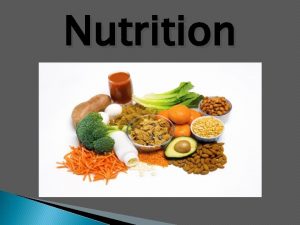Chapter 10 Nutrition and Your Health Lesson 1




























- Slides: 28

Chapter 10 Nutrition and Your Health

Lesson 1 Food in Your life l Hunger, appetite, obesity, Nutrition

Your body’s need for food l l l Hunger – a natural drive that protects you from starvation. Best diet – when your stomach growls- listen to your body. Stomach’s signal – walls contract and nerves send signal to the brain.

Your Mind’s Desire l l Why do people eat? Gluttony? They eat in response to their appetite. Appetite – the body’s desire, rather than the need, to eat. This is a learn , not inborn, response to food.

What causes us to eat? l l l List of all the environmental factors that cause us to eat: Culture, family, social relationships, media messages, lifestyle What causes you to eat? Why do you eat?

Emotions cause us to eat or not eat l l Stress Boredom Sadness/Depression Tension reliever

Managing Your Eating Habits 1) Avoid being influenced by others in making your food choices. Keep health in mind. 2) Pay attention to quantity. 3) Make something other than food the focus of everyday social occasions.

Your Eating Habits l l You can reduce the risk of chronic diseases by choosing food that tastes good and provides nutrients without too much fat, cholesterol, and sodium. Obesity – chronic disease of being overweight High Blood Pressure High Cholesterol

Eating linked to disease l Unhealthy eating has been connected to 6 out of the 10 leading causes of death in the US.

Lesson 2 Nutrients: Carbohydrates, Proteins, and Fats. l Terms : Carbohydrates, Glucose, Glycogen , proteins, amino acids, lipid, linoleic acid, cholesterol

Carbohydrates l l Made up of carbon, oxygen, and hydrogen They are starches and sugars found in foods. The body’s preferred source of energy, providing 4 calories per gram. Simple and complex

Simple and Complex Carbs l l Simple – Sugars - that are present in naturally in fruits, some vegetables, and milk. Also added to many candies. Complex – Starches – found in great supply in rice and other seed grains. They are chemically more complexed than sugars. They are actually many sugars put together that the body must break down into sugar.

Role of Carbohydrates l l He body uses carbs to convert them into glucose. Glucose is the body’s chief fuel source. Glucose that is not used is stored as Glycogen in the liver or muscles until the body needs it. The Glycogen is then broken back down into glucose. Glucose that is not needed is turn into adipose tissue or FAT.

Fiber l l A special form of complex carbohydrates Found in the tough , stringy parts of vegetables Helps in digestion Helps reduce the risk of heart disease

Protein l l l Nutrients that help build and maintain body tissues Muscle , bones, connective tissue, blood, and vital organs all contain protein. Amino Acids – the building blocks of protein Substances that make up body proteins. Body can make all but 9 of the amino acids called essential amino acids. Come from food.

Role of Proteins l l Build new tissue throughout life Regulate body processes

Types of Proteins l l Complete – are foods that contain all the essential amino acids that the body needs and in the proper amounts. Ex. – fish, meat, poultry, eggs, milk, cheese, yogart Incomplete – are foods that lack all the essential amino acids Ex – nuts, whole grains, and seeds

Fats l l l Represent the most concentrated form of energy available, gram for gram they deliver twice the amount of energy as carbohydrates Composed of carbon, hydrogen and oxygen Saturated and unsaturated Fats are made of fatty acids and are a type of lipid Lipid – substances that cannot dissolve in water

Saturated l l l Fatty acids that hold all the hydrogen atoms it can. Ex – animal fat, tropical oils (Palm oil), Coconut oil, fat in beef , egg yolk, pork Associated with higher risk of heart disease,

Unsaturated l l Fatty acid that is missing one or more pairs of hydrogen atoms. Ex – vegetable fat, olive oil, corn oil, soybean, corn Associated with a reduced risk of heart disease Margarine – vegetable oil in hydrogenated form.

The Role of Fats l l l They are an integral part to many important health functions. They carry vitamin A, D, E and K into your blood and serve as sources of linoleic acid. Linoleic acid is an essential fatty acid not made in the body but which is essential for growth and development. Add flavor in foods Satisfy hunger longer because they take longer to digest.

Cholesterol l l A fatlike substance produced in the liver of animals Only found in meats Body produces enough Associate with increased risk with heart disease and circulatory disease.

Vitamins l l l Compounds that help regulate many vital body processes including the digestion, absorption, and metabolism of other nutrients. Of the 13 that the body needs the body only makes Vitamin D. Two types: Water-soluble and fat-soluble

Water soluble l l l Dissolve in water and therefore it passes into the bloodstream easily. Excess leaves in the form of urine Body does not store, so we must replenish constantly

Fat-soluble l l l Vitamins that are absorbed and transported by fat. Vitamins A, D, E and K. These are absorbed in the fat tissues , liver and kidneys. An excess of these can have a negative effect on the body.

Minerals l l l Inorganic substances that the body cannot manufacture but that act as a catalyst, regulating many vital body processes. The body needs very little. Best source is the food we eat.

Water l l l Makes up the greatest amount of a nutrient in the body. Water carries nutrients to and transports waste from your cells. Body uses about 10 cups a day.

Lesson 3 assignment l l l You will be assigned a vitamin or mineral to complete a report for the class. The report should be one page in length handwritten. The report will be due Thursday. Use book in class, media center, public library or internet. I will give class time on Tuesday.
 A saturated fatty acid holds all the hydrogen atoms it can.
A saturated fatty acid holds all the hydrogen atoms it can. Overall state of well being or total health
Overall state of well being or total health Chapter 10 nutrition for health lesson 2 nutrients
Chapter 10 nutrition for health lesson 2 nutrients Chapter 10 lesson 4 nutrition labels and food safety
Chapter 10 lesson 4 nutrition labels and food safety Chapter 1 lesson 3 health risks and your behavior
Chapter 1 lesson 3 health risks and your behavior Related risks that increase in effect with each added risk
Related risks that increase in effect with each added risk Chapter 1 lesson 3 health risks and your behavior
Chapter 1 lesson 3 health risks and your behavior Chapter 55 nutrition and health
Chapter 55 nutrition and health Chapter 10 lesson 4 nutrition labels and food safety
Chapter 10 lesson 4 nutrition labels and food safety Kelsey carbonetta
Kelsey carbonetta Chapter 7 nutrition and your fitness
Chapter 7 nutrition and your fitness Chapter 4 nutrition and your personal fitness
Chapter 4 nutrition and your personal fitness Seven nutrition and fitness
Seven nutrition and fitness Chapter 1 lesson 2 what affects your health answers
Chapter 1 lesson 2 what affects your health answers Chapter 1 understanding health and wellness lesson 2
Chapter 1 understanding health and wellness lesson 2 Chapter 2 taking charge of your health worksheet answer key
Chapter 2 taking charge of your health worksheet answer key Glencoe health chapter 1 understanding health and wellness
Glencoe health chapter 1 understanding health and wellness Building health skills chapter 2
Building health skills chapter 2 Chapter 1 understanding health and wellness
Chapter 1 understanding health and wellness Chapter 10 nutrition for health vocabulary practice
Chapter 10 nutrition for health vocabulary practice Chapter 10 lesson 1 the importance of nutrition
Chapter 10 lesson 1 the importance of nutrition Project title for health and nutrition
Project title for health and nutrition Datingoo
Datingoo Unit 3 nutrition lesson 6 anorexia nervosa and bulimia
Unit 3 nutrition lesson 6 anorexia nervosa and bulimia Lesson 3 taking responsibility for your health
Lesson 3 taking responsibility for your health Rolling the dice and taking chances chapter 1 lesson 3
Rolling the dice and taking chances chapter 1 lesson 3 Chapter 3 health wellness and health disparities
Chapter 3 health wellness and health disparities Lesson 4 promoting health and wellness
Lesson 4 promoting health and wellness Chapter 1 understanding health and wellness lesson 4
Chapter 1 understanding health and wellness lesson 4
